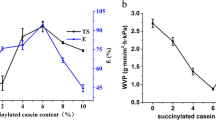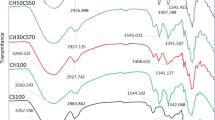Abstract
This research has proved that polyaldehydes derived from sucrose are effective in improving the dry and wet mechanical properties and cytocompatibility of zein films. Zein is a corn-derived storage protein with satisfactory film-forming ability and proven biosafety, and thus has been used in biomedical and food packaging fields. However, under normal conditions, pristine zein films have poor tensile properties in the dry or wet state, and cross-linking is required to improve these properties. Heretofore, most powerful cross-linkers are toxic and environmentally harmful, while safe cross-linkers are less efficient. In this study, zein films were cross-linked with a safe and effective biobased polyaldehydes derived from sucrose. The wet and dry tensile properties of the zein films were improved without compromising their clarity and UV shielding ability. Unexpectedly, cell culture studies showed significantly enhanced cytocompatibility of zein films after polyaldehydes cross-linking. Therefore, polyaldehyde cross-linked zein films with improved properties may serve as potential candidates for biomedical and packaging applications.






Similar content being viewed by others
References
Hernandez-Izquierdo V, Krochta J (2008) Thermoplastic processing of proteins for film formation—a review. J Food Sci 73:R30–R39. https://doi.org/10.1111/j.1750-3841.2007.00636.x
Mu B, Hassan F, Yang Y (2020) Controlled assembly of secondary keratin structures for continuous and scalable production of tough fibers from chicken feathers. Green Chem 22:1726–1734. https://doi.org/10.1039/c9gc03896e
Mu B, Xu H, Li W, Xu L, Yang Y (2019) Spinnability and rheological properties of globular soy protein solution. Food Hydrocoll 90:443–451. https://doi.org/10.1016/j.foodhyd.2018.12.049
Kurek M, Guinault A, Voilley A, Debeaufort F (2014) Effect of relative humidity on carvacrol release and permeation properties of chitosan based films and coatings. Food Chem 144:9–17. https://doi.org/10.1016/j.foodchem.2012.11.132
Jimenez A, Fabra MJ, Talens P, Chiralt A (2012) Edible and biodegradable starch films: a review. Food Bioprocess Technol 5:2058–2076. https://doi.org/10.1007/s11947-012-0835-4
Xu H, Jiang Q, Reddy N, Yang Y (2011) Hollow nanoparticles from zein for potential medical applications. J Mater Chem 21:18227–18235. https://doi.org/10.1039/c1jm11163a
Hu C, Reddy N, Luo Y, Yan K, Yang Y (2011) Thermoplastics from acetylated zein-and-oil-free corn distillers dried grains with solubles. Biomass Bioenerg 35:884–892. https://doi.org/10.1016/j.biombioe.2010.11.006
Gregg K, Rogers GE (1986) Feather keratin: composition, structure and biogenesis. In: Biology of the integument. Springer, pp 666–694. https://doi.org/10.1007/978-3-662-00989-5_33
Claessens M, Saris WH, van Baak MA (2008) Glucagon and insulin responses after ingestion of different amounts of intact and hydrolysed proteins. Br J Nutr 100:61–69. https://doi.org/10.1017/S0007114507886314
Ibarra VG, Sendón R, De Quirós ARB (2016) Antimicrobial food packaging based on biodegradable materials. Antimicrobial food packaging. Elsevier, pp. 363–384. https://doi.org/10.1016/b978-0-12-800723-5.00029-2
Xu H, Yang Y (2014) Controlled de-cross-linking and disentanglement of feather keratin for fiber preparation via a novel process. ACS Sustain Chem Eng 2:1404–1410. https://doi.org/10.1021/sc400461d
Xu H, Cai S, Xu L, Yang Y (2014) Water-stable three-dimensional ultrafine fibrous scaffolds from keratin for cartilage tissue engineering. Langmuir 30:8461–8470. https://doi.org/10.1021/la500768b
Lai HM, Padua GW (1998) Water vapor barrier properties of zein films plasticized with oleic acid. Cereal Chem 75:194–199. https://doi.org/10.1094/CCHEM.1998.75.2.194
Parris N, Coffin DR (1997) Composition factors affecting the water vapor permeability and tensile properties of hydrophilic zein films. J Agric Food Chem 45:1596–1599. https://doi.org/10.1021/jf960809o
Xu H, Chai Y, Zhang G (2012) Synergistic effect of oleic acid and glycerol on zein film plasticization. J Agric Food Chem 60:10075–10081. https://doi.org/10.1021/jf302940j
Luecha J, Sozer N, Kokini JL (2010) Synthesis and properties of corn zein/montmorillonite nanocomposite films. J Mater Sci 45:3529–3537. https://doi.org/10.1007/s10853-010-4395-6
Migneault I, Dartiguenave C, Bertrand MJ, Waldron KC (2004) Glutaraldehyde: behavior in aqueous solution, reaction with proteins, and application to enzyme crosslinking. Biotechniques 37:790–802. https://doi.org/10.2144/04375RV01
Di Stefano F, Siriruttanapruk S, McCoach J, Sherwood Burge P (1999) Glutaraldehyde: an occupational hazard in the hospital setting. Allergy 54:1105–1109. https://doi.org/10.1034/j.1398-9995.1999.00239.x
Powers CN, Osier JL, McFeeters RL, Brazell CB, Olsen EL, Moriarity DM, Satyal P, Setzer WN (2018) Antifungal and cytotoxic activities of sixty commercially-available essential oils. Molecules 23:1549–1561. https://doi.org/10.3390/molecules23071549
Dou Y, Huang X, Zhang B, He M, Yin G, Cui Y (2015) Preparation and characterization of a dialdehyde starch crosslinked feather keratin film for food packaging application. Rsc Adv 5:27168–27174. https://doi.org/10.1039/C4RA15469J
Yue H, Zheng Y, Zheng P, Guo J, Fernández-Blázquez JP, Clark JH, Cui Y (2020) On the improvement of properties of bioplastic composites derived from wasted cottonseed protein by rational cross-linking and natural fiber reinforcement. Green Chem 22:8642–8655
Liu P, Xu H, Mi X, Xu L, Yang Y (2015) Oxidized sucrose: a potent and biocompatible crosslinker for three-dimensional fibrous protein scaffolds. Macromol Mater Eng 300:414–422. https://doi.org/10.1002/mame.201400373
Mu B, Xu L, Yang Y (2021) Flexible and wet stable starch films crosslinked with sugar-based aldehydes. IND Crop Prod 173:114109–114117. https://doi.org/10.1016/j.indcrop.2021.114109
Mu B, Wu Q, Xu L, Yang Y (2022) A sustainable approach to synchronous improvement of wet-stability and toughness of chitosan films. Food Hydrocoll 123:107138–107145. https://doi.org/10.1016/j.foodhyd.2021.107138
Hernández-Muñoz P, López-Rubio A, Del-Valle V, Almenar E, Gavara R (2004) Mechanical and water barrier properties of glutenin films influenced by storage time. J Agric Food Chem 52:79–83. https://doi.org/10.1021/jf034763s
Yu S-H, Tsai M-L, Lin B-X, Lin C-W, Mi F-L (2015) Tea catechins-cross-linked methylcellulose active films for inhibition of light irradiation and lipid peroxidation induced β-carotene degradation. Food Hydrocoll 44:491–505. https://doi.org/10.1016/j.foodhyd.2014.10.022
Arfat YA, Benjakul S, Prodpran T, Osako K (2014) Development and characterisation of blend films based on fish protein isolate and fish skin gelatin. Food Hydrocoll 39:58–67. https://doi.org/10.1016/j.foodhyd.2013.12.028
Abdollahi M, Alboofetileh M, Behrooz R, Rezaei M, Miraki R (2013) Reducing water sensitivity of alginate bio-nanocomposite film using cellulose nanoparticles. Int J Biol Macromol 54:166–173. https://doi.org/10.1016/j.ijbiomac.2012.12.016
Xie S, Zhao J, Zhang B, Wang Z, Ma H, Yu C, Yu M, Li L, Li J (2015) Graphene oxide transparent hybrid film and its ultraviolet shielding property. ACS Appl Mater Inter 7:17558–17564. https://doi.org/10.1021/acsami.5b04231
Mu B, Hassan F, Wu Q, Yang Y (2022) Pilot-scale spinning and sucrose-tetra-aldehydes-crosslinking of feather-derived protein fibers with improved mechanical properties and water resistance. Sustain Mater Technol 31:e00367–e00374. https://doi.org/10.1016/j.susmat.2021.e00367
Roberts M, Bentley M, Harris J (2002) Chemistry for peptide and protein PEGylation. Adv Drug Deliv Rev 54:459–476. https://doi.org/10.1016/j.addr.2012.09.025
Yue H-B, Fernandez-Blazquez J, Shuttleworth PS, Cui Y-D, Ellis G (2014) Thermomechanical relaxation and different water states in cottonseed protein derived bioplastics. Rsc Adv 4:32320–32326. https://doi.org/10.1039/c4ra01794c
Zhang Y, Niu Y, Yao F, Dai B, Wang Q, Yu L (2014) Preparation of novel cross-linked and octylated caseinates using a biphasic enzymatic procedure and their functional properties. J Agric Food Chem 62:8655–8662. https://doi.org/10.1021/jf5024998
Hassan AB, Osman GA, Babiker EE (2007) Effect of chymotrypsin digestion followed by polysaccharide conjugation or transglutaminase treatment on functional properties of millet proteins. Food Chem 102:257–262. https://doi.org/10.1016/j.foodchem.2006.04.043
Hu X, Kaplan D, Cebe P (2006) Determining beta-sheet crystallinity in fibrous proteins by thermal analysis and infrared spectroscopy. Macromolecules 39:6161–6170. https://doi.org/10.1021/ma0610109
Sun TW, Zhu YJ, Chen F, Zhang YG (2017) Ultralong hydroxyapatite nanowire/collagen biopaper with high flexibility, improved mechanical properties and excellent cellular attachment. Chem Asian J 12:655–664. https://doi.org/10.1002/asia.201601592
Haugh MG, Murphy CM, McKiernan RC, Altenbuchner C, O’Brien FJ (2011) Crosslinking and mechanical properties significantly influence cell attachment, proliferation, and migration within collagen glycosaminoglycan scaffolds. Tissue Eng Part A 17:1201–1208. https://doi.org/10.1089/ten.tea.2010.0590
Sessa DJ, Mohamed A, Byars JA, Hamaker SA, Selling GW (2007) Properties of films from corn zein reacted with glutaraldehyde. J Appl Polym Sci 105:2877–2883. https://doi.org/10.1002/app.26272
Turasan H, Barber EA, Malm M, Kokini JL (2018) Mechanical and spectroscopic characterization of crosslinked zein films cast from solutions of acetic acid leading to a new mechanism for the crosslinking of oleic acid plasticized zein films. Food Res Int 108:357–367. https://doi.org/10.1016/j.foodres.2018.03.063
Oh JH, Wang B, Field PD, Aglan HA (2004) Characteristics of edible films made from dairy proteins and zein hydrolysate cross-linked with transglutaminase. Int J Food Sci Tech 39:287–294. https://doi.org/10.1111/j.1365-2621.2004.00783.x
Ahammed S, Liu F, Wu J, Khin MN, Yokoyama WH, Zhong F (2021) Effect of transglutaminase crosslinking on solubility property and mechanical strength of gelatin-zein composite films. Food Hydrocoll 116:106649–106659. https://doi.org/10.1016/j.foodhyd.2021.106649
Liang J, Chen R (2018) Impact of cross-linking mode on the physical properties of zein/PVA composite films. Food Packag Shelf 18:101–106. https://doi.org/10.1016/j.fpsl.2018.10.003
Acknowledgements
The authors appreciated the insightful advice from Dr. Helan Xu.
Author information
Authors and Affiliations
Corresponding author
Ethics declarations
Conflict of interest
On behalf of all authors, the corresponding author states that there is no conflict of interest.
Additional information
Handling Editor: Maude Jimenez.
Publisher's Note
Springer Nature remains neutral with regard to jurisdictional claims in published maps and institutional affiliations.
Rights and permissions
Springer Nature or its licensor (e.g. a society or other partner) holds exclusive rights to this article under a publishing agreement with the author(s) or other rightsholder(s); author self-archiving of the accepted manuscript version of this article is solely governed by the terms of such publishing agreement and applicable law.
About this article
Cite this article
Liu, P., Zhou, Z. & Mu, B. Highly ductile corn protein films cross-linked with biobased aldehydes for biomedical and packaging applications. J Mater Sci 57, 19502–19512 (2022). https://doi.org/10.1007/s10853-022-07860-y
Received:
Accepted:
Published:
Issue Date:
DOI: https://doi.org/10.1007/s10853-022-07860-y




